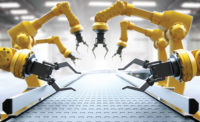Machinery Technology: Machinery/equipment: Robotics & automation
The robotics and automation solutions streamlining today’s packaging processes
Latest innovations employ fast changeovers, sustainability, flexibility and more.

The IRB 910 SC (SCARA) from ABB Robotics is fast, cost-effective and accurate.

The UR3 from Universal Robotics is a compact table-top robot weighing only 24.3 lbs, with a payload of 6.6 lbs, 360-degree rotation on all wrist joints and infinite rotation on the end joint.

The Integra 520V from Marchesini Group is a robotized integrated blister line ideal for single-blister cartons, able to package 520 blisters and 500 cartons per minute.



Robotics and automation have both long served the packaging industry, speeding up the packaging process, increasing sustainability and efficiency, all with safety in mind.
According to the Robotic Industries Association (RIA; robotics.org), robot orders and shipments in North America set new records with 22,427 robots valued at $1.3 billion ordered in the first nine months of 2015 from North American companies, breaking the previous record set in 2014 by 16% in units and 10% in dollars.
There seems to be no signs of the robotics market slowing down, with new trends and innovations always on the horizon.
“One trend, other than application of industrial robots to machine functions traditionally reserved for hard automation, is the introduction of collaborative robots or “cobotics” to various functions up and down the production line,” says Scott Reed, vice president, sales, marketing & customer service for ADCO Manufacturing (adcomfg.com). “My impression is that while there is still a lot of development needed before collaborative robots make their way into most production environments, there is a lot of upside potential for both OEM’s and end-users. With the inherent flexibility, portability, simplicity and obviously, safety, I am sure that the popularity and use of collaborative robots will continue to rise.”
Scott Mabie, general manager of Universal Robots (universal-robots.com), Americas Division also sees the prevalent trend of cobotics. “The overarching trend is ever closer human-robot collaboration,” he says. “The robots are moving out of their cages and are increasingly being integrated in applications where employees work side-by-side with the robots.”
Two other trends Mabie is seeing is one, “the ability for virtually anyone to program/work with a robot, due to an increase in demand for robots and automation to be more accessible.” And two, “robots truly become redeployable tools used in a variety of applications.”
Aside from market trends, manufacturers are also noticing the new needs and inclinations customers are requesting more prevalently.
“Customers – especially in the packaging industry – are challenged with high mix/low volume production runs that require fast change overs and flexible automation solutions,” explains Mabie. “Traditional industrial robots that stay hardwired inside safety enclosures are unable to meet this challenge.”
According to Mabie, Universal Robots is addressing these issues with lightweight, user-friendly robot arms that can quickly be redeployed between ever-changing tasks in agile production environments. Or in other words, cobots.
Sustainability is also a constant discussion in the packaging industry, and according to Mabie and Reed, it’s playing a role in many ways within the market, impacting both production and efficiency greatly.
“Automation, whether or not you employ a robot, has a proven impact on overall productivity and efficiency,” says Reed. “Aside from reducing energy use, if you correctly apply robotics and automation to certain processes you will undoubtedly reduce errors and rework. The reduction or elimination of waste in any process, whether achieved through automation or not, has a clear and direct correlation to sustainability.”
Employing many of the trends above, including sustainability, cobots, flexibility and more, the following are just a few of the latest robotic and automation innovations that are fueling and enhancing the market of today.
Fast, cost-effective and accurate, ABB Robotics’ (abb.com) Selective Compliance Articulated Robot Arm (SCARA), or IRB 910SC, family has a maximum payload of 6 kg, the IRB 910SC and is available in three configurations. All types are modular by design, with different linking arm lengths and have individual reaches of 450mm, 550mm and 650mm.
According to company press materials, the SCARA family is designed for general-purpose applications that need fast, repeatable and articulate point-to-point movements including palletizing, depalletizing, machine loading/unloading and assembly and is ideal for rapid cycle times, high precision and reliability for small part assembly applications and is suitable for laboratory automation and prescription drug dispensing.
Presented for the first time at Achema 2015, Marchesini Group’s (marchesini.com) robotized integrated blister line Integra 520V is compact, combining two machines, a thermoformer and a cartoner.
The Integra 520V is the larger model of the Integra 320, featuring the same innovative functions of Integra 320, along with new pushers, a drum-type carton opener to deal with high speeds and a new leaflet pick-and-place system. The final outcome is an ideal machine for single-blister cartons. The line is easy to clean and to change over size, thanks to the separate product feeding area from the electrical and mechanical area. All mechanisms are in an oil bath, making them long-lasting and more resistant to wear and tear.
New from Universal Robotics, launched in 2015, the UR3 is a compact table-top robot weighing only 24.3 pounds, but has a payload of 6.6 pounds, 360-degree rotation on all wrist joints and infinite rotation on the end joint. According to the company, these features make UR3 one of the most flexible, lightweight, table-top robots to work side-by-side with employees in the market today. The UR3 is an ideal choice for applications requiring 6-axis capabilities where size, safety and costs are critical.
“UR3 is an optimal assistant in assembly, packaging, polish, glue and screw applications requiring uniform product quality. The new robot can also be used in a separate work station mounted on the table, picking, assembling and placing parts in optimized production flows,” says Mabie. “UR3 has 15 advanced, adjustable safety settings. One of these is the unique force sensing that enables the UR3 to limit the forces at contact if the robot collides with an employee. The new robot has a default force sensing of 150 Newton but can be set to stop if it encounters a force as low as 50 Newton in its route.”
These innovative robotics and automation examples prove that the industry is expanding, assisting, enhancing and speeding up the packaging process for packagers everywhere.
Looking for a reprint of this article?
From high-res PDFs to custom plaques, order your copy today!











